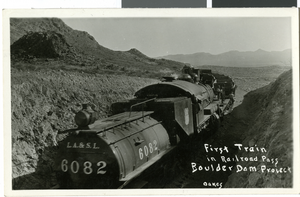Search the Special Collections and Archives Portal
Search Results
Sarann Knight Preddy, Elizabeth Warren, and Woodrow Wilson oral history interview
Identifier
Abstract
Oral history interview with Sarann Knight Preddy, Elizabeth Warren, and Woodrow Wilson conducted by Porter Troutman on July 19, 1977 for the Ralph Roske Oral History Project on Early Las Vegas. In this forum, Knight, Warren, and Wilson discuss the history of West Las Vegas, Nevada. Knight recalls arriving to Las Vegas in 1942 and describes the African American experience at that time. She talks about being the first woman of color to receive a gaming license, dealing cards, and the city ordinance which banned African American dealers. Wilson remembers the living conditions before federal housing and race restrictive covenants in housing. Then, Warren talks about the city's early years, the history of discrimination against African Americans in the city, and the significance of the railroad in Las Vegas. The group answers questions asked by audience members throughout the duration of the forum.
Archival Collection

Tonopah Depot: photographic print
Date
Archival Collection
Description
From the Nye County, Nevada Photograph Collection (PH-00221) -- Series VI. Tonopah, Nevada -- Subseries VI.D. Terrell Family. Man on the far right may be Don Terrell. With the mines and mills in Tonopah shut down, the railroad was losing money. The contraption above was constructed to carry passengers on the railroad wheels. The gas tank is visible on the roof of the car.
Image

Map showing the Union Pacific Railway and connecting railroads, 1888
Date
Description
Image

Letter from Roy A. Wehe (San Francisco) to Edward C. Renwick (Los Angeles), November 23, 1951
Date
Archival Collection
Description
If the Union Pacific should divest itself of water production to the Las Vegas Land and Water Company, Wehe describes what the operation of the company should look like. Letter has several date stamps, including one from E. E. Bennett and one from the Union Pacific Railroad Law Department.
Text

View of Tonopah from Railroad Depot: photograph
Date
Archival Collection
Description
Image

Negative: Tonopah and Tidewater Engine No. 8: photographic print
Date
Archival Collection
Description
From the Nye County, Nevada Photograph Collection (PH-00221) -- Series III. Beatty, Nevada -- Subseries III.G. Reidhead Family.
Image

Postcard of a Union Pacific Railroad train, during Hoover Dam construction, late 1920s - early 1930s
Date
Archival Collection
Description
Image

Newspaper clipping, Where I stand, Las Vegas Sun, May 9, 1953
Date
Archival Collection
Description
Editorial from the Las Vegas Sun. Unlike a noble French merchant, who sacrificed greatly to give the people of Marseilles good water, the water company is trying to bleed all the money they can out of the situation before surrendering it to the water district. "80-11" written in red pencil. Date stamp from E.C.R.
Text
Ferron and Bracken Photograph Collection
Identifier
Abstract
The Ferron and Bracken Photograph Collection depicts Southern and Central Nevada and other western states from 1890 to 1961. The photographs primarily depict the development and growth of early Las Vegas, Nevada; mines and mining operations in Southern and Central Nevada; towns and mines in Nevada; and the Hoover (Boulder) Dam and the Colorado River.
Archival Collection

Transcript of interview with Ralph Daly by Charles Malkowski, February 25, 1977
Date
Archival Collection
Description
Text
